新版pep小学三年级英语下册Unit3 At the zoo A.Let's talk公开课PPT课件
- 格式:ppt
- 大小:2.15 MB
- 文档页数:34
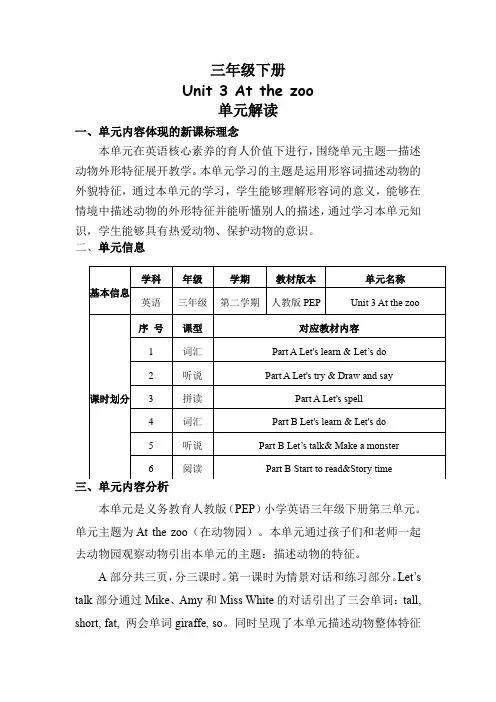
三年级下册Unit 3 At the zoo单元解读一、单元内容体现的新课标理念本单元在英语核心素养的育人价值下进行,围绕单元主题—描述动物外形特征展开教学。
本单元学习的主题是运用形容词描述动物的外貌特征,通过本单元的学习,学生能够理解形容词的意义,能够在情境中描述动物的外形特征并能听懂别人的描述,通过学习本单元知识,学生能够具有热爱动物、保护动物的意识。
二、单元信息本单元是义务教育人教版(PEP)小学英语三年级下册第三单元。
单元主题为At the zoo(在动物园)。
本单元通过孩子们和老师一起去动物园观察动物引出本单元的主题:描述动物的特征。
A部分共三页,分三课时。
第一课时为情景对话和练习部分。
Let’s talk部分通过Mike、Amy和Miss White的对话引出了三会单词:tall, short, fat, 两会单词giraffe, so。
同时呈现了本单元描述动物整体特征的句式:Look at that giraffe. It’s so tall. 在画一画,说一说的练习中,Chen Jie和John分别画了自己的动物,并使用重点句式来描述其特征。
学生通过这样的活动来操练在对话中学习到的重点句式。
第二课时为重点词汇和重点句型呈现,孩子们继续在动物园里游玩,发现了monkey和giraffe,从而呈现出三会词汇:tall, short, fat, thin,以及在Let’s talk中出现的描述动物的特征的句式:Look at that monkey. It’s fat. Let’s do是指令活动,学生需要根据指示做到变胖、变瘦、变高、变矮的动作,从而操练重点单词。
第三课时为语音学习,通过听一听、读一读、唱一唱、写一写活动,让学生理解并掌握字母i在单词里发的短音/ ɪ /。
B部分共四页,分三课时。
第一课时呈现情景对话和练习。
Miss White 带着孩子们观察大象,孩子们开始描述它具有的具体特征。
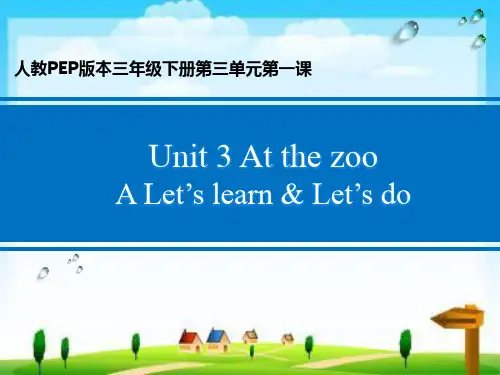
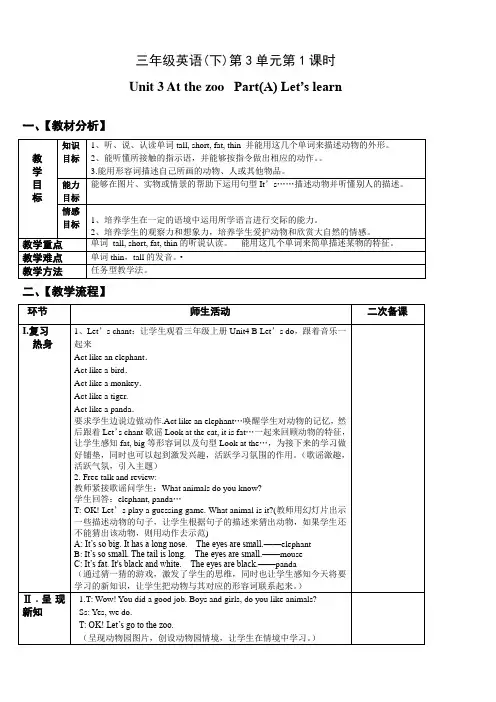
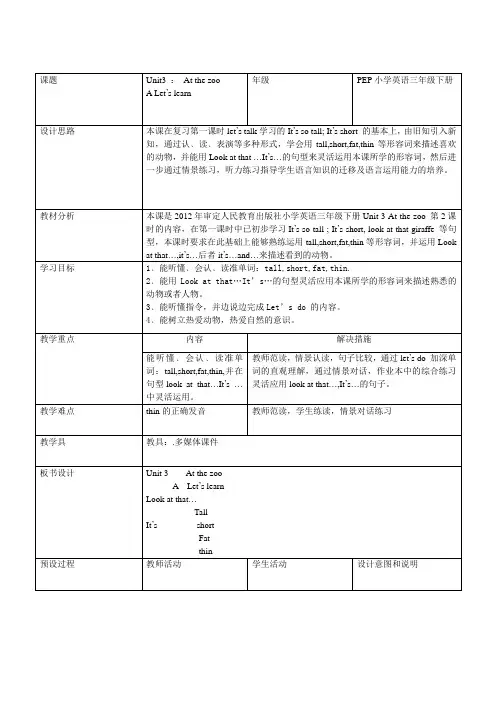
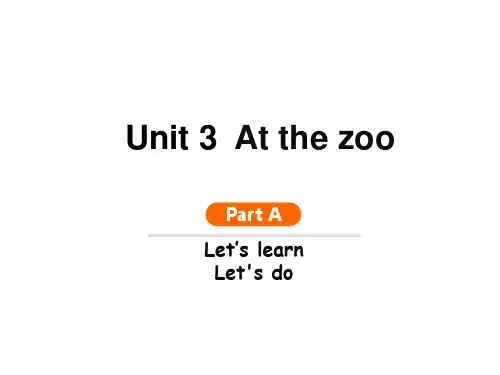
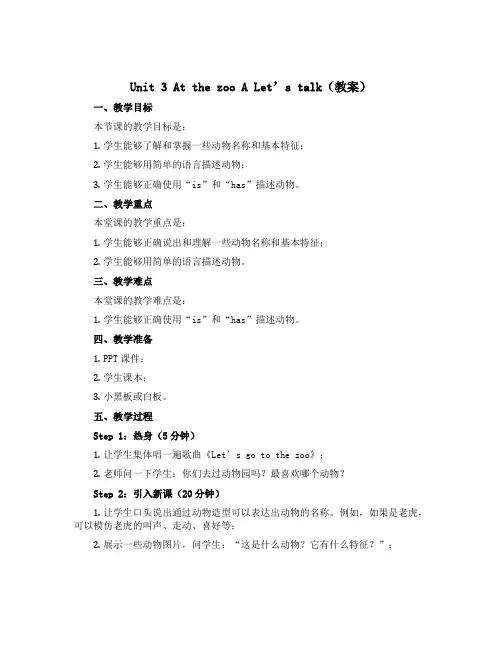
Unit 3 At the zoo A Let’s talk(教案)一、教学目标本节课的教学目标是:1.学生能够了解和掌握一些动物名称和基本特征;2.学生能够用简单的语言描述动物;3.学生能够正确使用“is”和“has”描述动物。
二、教学重点本堂课的教学重点是:1.学生能够正确说出和理解一些动物名称和基本特征;2.学生能够用简单的语言描述动物。
三、教学难点本堂课的教学难点是:1.学生能够正确使用“is”和“has”描述动物。
四、教学准备1.PPT课件;2.学生课本;3.小黑板或白板。
五、教学过程Step 1:热身(5分钟)1.让学生集体唱一遍歌曲《Let’s go to the zoo》;2.老师问一下学生:你们去过动物园吗?最喜欢哪个动物?Step 2:引入新课(20分钟)1.让学生口头说出通过动物造型可以表达出动物的名称。
例如,如果是老虎,可以模仿老虎的叫声、走动、喜好等;2.展示一些动物图片,问学生:“这是什么动物?它有什么特征?”;3.教师用PPT展示和解释一下,例如老虎:Tiger。
It has a big head and sharp claws. It is yellow and black. It can run very fast. It likes to eat meat.4.教师与学生一起描述一些其他的动物,例如各种动物的皮毛、眼睛、耳朵等特征。
Step 3:小练习(10分钟)1.让学生带好课本,找出书中有关动物的图片并用英语描述一下;2.如果学生表现得不错,可以组织一些小组间的竞赛,让学生更加积极投入学习。
Step 4:总结(5分钟)1.教师简要地总结一下本节课所学的内容和重点;2.教师强调学生需要通过实践来加深对动物的认识,并鼓励学生到动物园或者野外接触动物。
六、课后作业1.学生需要将本节课所学的内容记忆牢固,可以通过一些背诵、写字、绘画等方式完成。
2.学生还可以通过观看动物题材的动画片、电视剧等进行复习和加深理解。
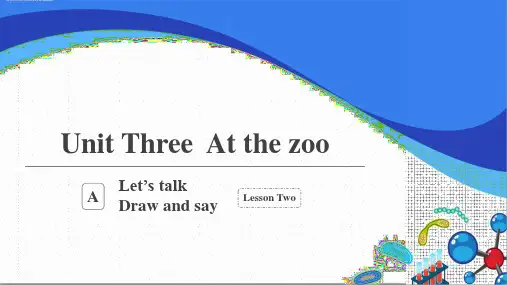
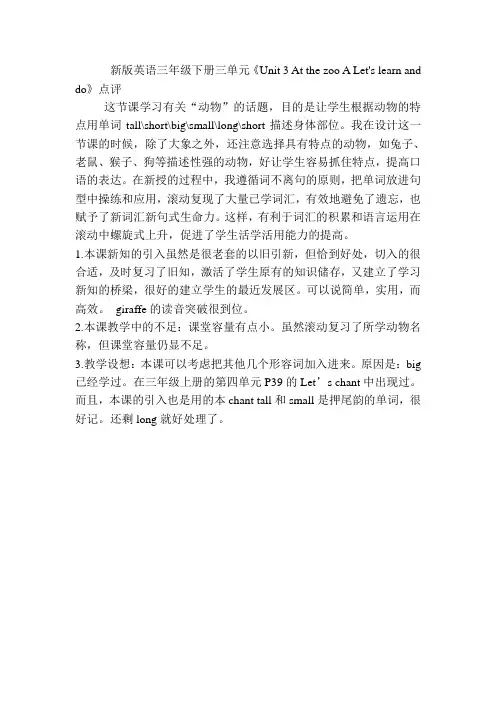
新版英语三年级下册三单元《Unit 3 At the zoo A Let's learn and do》点评
这节课学习有关“动物”的话题,目的是让学生根据动物的特点用单词tall\short\big\small\long\short描述身体部位。
我在设计这一节课的时候,除了大象之外,还注意选择具有特点的动物,如兔子、老鼠、猴子、狗等描述性强的动物,好让学生容易抓住特点,提高口语的表达。
在新授的过程中,我遵循词不离句的原则,把单词放进句型中操练和应用,滚动复现了大量已学词汇,有效地避免了遗忘,也赋予了新词汇新句式生命力。
这样,有利于词汇的积累和语言运用在滚动中螺旋式上升,促进了学生活学活用能力的提高。
1.本课新知的引入虽然是很老套的以旧引新,但恰到好处,切入的很合适,及时复习了旧知,激活了学生原有的知识储存,又建立了学习新知的桥梁,很好的建立学生的最近发展区。
可以说简单,实用,而高效。
giraffe的读音突破很到位。
2.本课教学中的不足:课堂容量有点小。
虽然滚动复习了所学动物名称,但课堂容量仍显不足。
3.教学设想:本课可以考虑把其他几个形容词加入进来。
原因是:big 已经学过。
在三年级上册的第四单元P39的Let’s chant中出现过。
而且,本课的引入也是用的本chant tall和small是押尾韵的单词,很好记。
还剩long就好处理了。
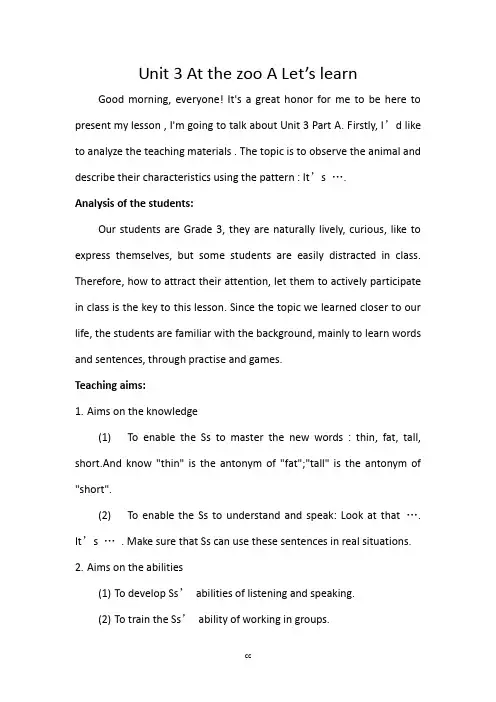
Unit 3 At the zoo A Let’s learnGood morning, everyone! It's a great honor for me to be here to present my lesson , I'm going to talk about Unit 3 Part A. Firstly, I’d like to analyze the teaching materials . The topic is to observe the animal and describe their characteristics using the pattern : It’s ….Analysis of the students:Our students are Grade 3, they are naturally lively, curious, like to express themselves, but some students are easily distracted in class. Therefore, how to attract their attention, let them to actively participate in class is the key to this lesson. Since the topic we learned closer to our life, the students are familiar with the background, mainly to learn words and sentences, through practise and games.Teaching aims:1.Aims on the knowledge(1)To enable the Ss to master the new words : thin, fat, tall, short.And know "thin" is the antonym of "fat";"tall" is the antonym of "short".(2)To enable the Ss to understand and speak: Look at that …. It’s …. Make sure that Ss can use these sentences in real situations.2.Aims on the abilities(1)To develop Ss’abilities of listening and speaking.(2)To train the Ss’ability of working in groups.(3) To cultivate Ss’abilities of communication and their innovation.3. Aims on the emotion(1) Cultivate students' interest in learning English.(2) To cultivate Ss’consciousness: protect the animals. Key-points of this lessonTo enable Ss to master new words.Difficult points(1)To help the Ss master the sentences: Look at that …. It’s …, and make sure they can use the structure correctly.(2)To finish the tasks by themselves.Teaching methodsAs we all know: the main aims of learning English in primary school is to cultivate pupils’basic abilities of listening and speaking and their good sense of the English language. So in this lesson I’ll mainly use Task-based teaching method ,TPR teaching method, Communicative language teaching method and so on.Teaching proceduresI’ll finish this lesson in four steps.Step1:Warm-up and preview1.Let’s do together2.Review words about animals.Step2: Presentation1.Show animals’pictures on the PPT one by one and teach new words .2.Play “Let’s learn”on the screen and Ss follow it.3.Ss use these sentences according to pictures.Step3: Practice1.Play a game : flash cards and Ss spell the words2.Play and watch “Let’s do”.3.Play a game:I say you do.4.At the zoo, we shouldn’t do ?Step4: Sum upIn this step, I will guide the Ss to conclude the key words and sentences.Step5: Homework1.Read words and sentences (3times).2.Draw a picture of a kind of animal which you like and write sentences, then introduce to your partner.Blackboard designUnit 3 At the zoo A Let’s learnthin fat tall shortLook at that…. It’s….That’s all .Thanks a lot for listening.。
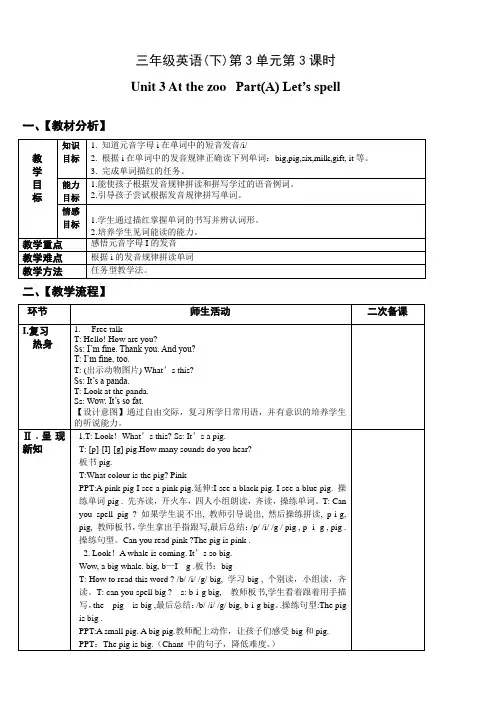
三年级英语(下)第3单元第3课时Unit 3 At the zoo Part(A) Let’s spell 一、【教材分析】二、【教学流程】T:What’s this?The elephant is big,too.3. How many pigs?Let’s count together.S: 1 , 2…..six pigs .six /s/ /i/ /ks/ six 操练单词six,. 齐读,小组读,齐读操练单词。
T: can you spell six ? 教师板书. 学生看着跟着用手描写,t six /s/ /i/ /ks/ six ,最后总结:/s/ /i/ /ks/ six ..操练句型。
4.师做喝牛奶的动作,并说:I like milk. Do you like milk? 引出milk. T: Look at the pig, what does it like? The pig likes milk .S: milk. /m/ /i/ /l/ /k / milk , 操练单词milk. 小组,齐读操练单词。
T: can you spell milk ? .教师板书. 学生看着跟着用手描写,T : m-i-l-k milk.Can you read?最后总结:/m/ /i/ /l/ /k / milk , m-i-l-k milk.操练句型。
教师呈现big, pig, six, milk四个单词的单词卡,让学生读出单词,然后让学生找找这四个单词的共同点。
(单词中都有字母i,i都发/i/音)但学生对这四个单词都发/i/音的规律不一定能说出,教师要引导并鼓励学生通过观察体验自己去发现和总结。
2. 播放课文录音,让学生进一步熟悉字母i在单词中的发音并跟着录音拼读单词。
(1)Listen and repeat.(2)Read together.(3)Read in pairsⅢ.巩固练习1.Play a game教师说一个单词,学生从字母卡中找出3个字母组成一个单词,同时叫2个学生,看谁做得快,谁就获得胜利,奖励一个笑脸。
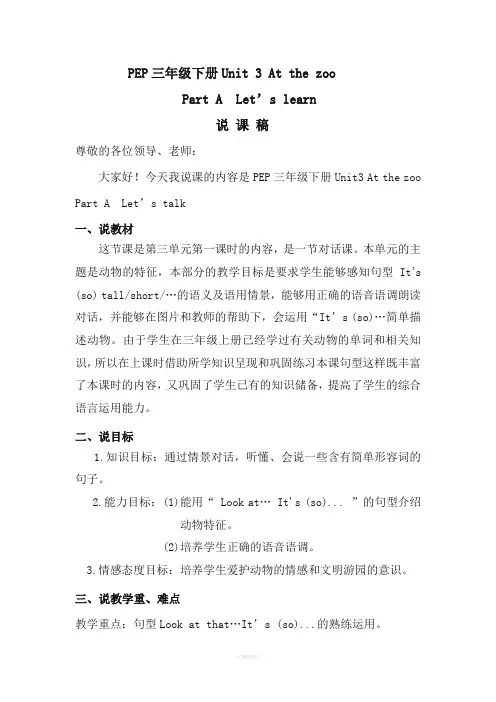
PEP三年级下册Unit 3 At the zooPart A Let’s learn说课稿尊敬的各位领导、老师:大家好!今天我说课的内容是PEP三年级下册Unit3 At the zoo Part A Let’s talk一、说教材这节课是第三单元第一课时的内容,是一节对话课。
本单元的主题是动物的特征,本部分的教学目标是要求学生能够感知句型It’s (so) tall/short/…的语义及语用情景,能够用正确的语音语调朗读对话,并能够在图片和教师的帮助下,会运用“It’s (so)…简单描述动物。
由于学生在三年级上册已经学过有关动物的单词和相关知识,所以在上课时借助所学知识呈现和巩固练习本课句型这样既丰富了本课时的内容,又巩固了学生已有的知识储备,提高了学生的综合语言运用能力。
二、说目标1.知识目标:通过情景对话,听懂、会说一些含有简单形容词的句子。
2.能力目标:(1)能用“ Look at… It's (so)... ”的句型介绍动物特征。
(2)培养学生正确的语音语调。
3.情感态度目标:培养学生爱护动物的情感和文明游园的意识。
三、说教学重、难点教学重点:句型Look at that…It’s (so)...的熟练运用。
教学难点:在情景中运用fat, short, tall四、说教学过程本课以五步教学法为基础,对其进行整合,设立了热身复习、呈现操练、拓展巩固和情感教育三个阶段。
第一阶段是热身复习,我设计了Greetings, Let’s sing, Game:What’s missing?和Let’s chant四个环节。
师生问候可以拉近我与新学生的距离,便于教学活动的开展。
歌曲At the zoo与本课内容切合,同时能够创造轻松愉悦的学习氛围。
这两个环节达到了课前热身的目的。
What’s missing?的活动旨在复习有关动物的单词,为后面的巩固拓展活动做铺垫。
Let’s chant是三年级上册的内容,歌谣中含有形容词fat,big.既唤醒学生的知识储备,又自然地引入新知。